"American Star" - Trips and Treasures ...A Remembrance of Times both Better and Bittersweet
|
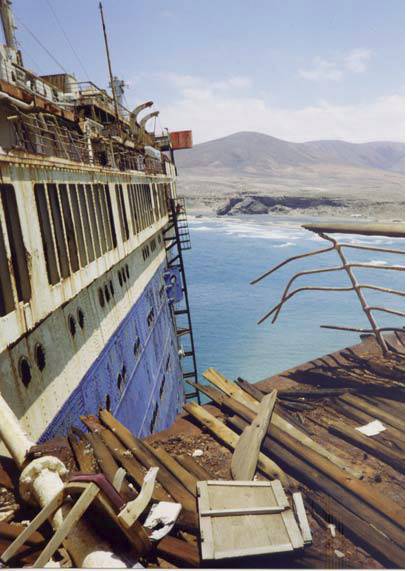 |
Introduction
 Of
all the adventurers that have been boarded the ill-fated AMERICAN STAR
since she went aground, Steve Tacey has had what is probably
the longest and most interesting association with this vessel. During
the 1970s, he enjoyed multiple voyages on the ship, when she was the
AUSTRALIS. Since 1994, he has made multiple pilgrimages to the Canary
Islands from his home in England, and managed to gain access to the
wreck on more than one occasion; taking home a large number of artifacts
and some unusual memories.
Of
all the adventurers that have been boarded the ill-fated AMERICAN STAR
since she went aground, Steve Tacey has had what is probably
the longest and most interesting association with this vessel. During
the 1970s, he enjoyed multiple voyages on the ship, when she was the
AUSTRALIS. Since 1994, he has made multiple pilgrimages to the Canary
Islands from his home in England, and managed to gain access to the
wreck on more than one occasion; taking home a large number of artifacts
and some unusual memories.
But that's not all. He has not only amassed an extensive collection, he has actually created some one-of-a-kind treasures; often working in association with "AMERICA's Unofficial Historian", Bill Lee. The following story is yet another of their collaborations ...
First Time Onboard
The first time I set foot onboard a passenger liner was wondrous, indeed. The occasion was my family’s great adventure - leaving England in 1974, combining a working holiday with visiting my Mother’s two sisters and her parents in New Zealand - more than halfway around the world. I was twelve years old at the time.
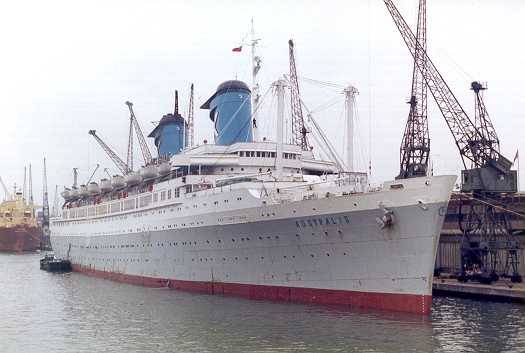 The
initial part of that memorable trip took place by bus, as my parents,
my younger sister and I journeyed from the only home I had known, in
Lincolnshire, to Southampton. After spending a night in a hotel, we
continued our trip via taxi to the now-demolished Ocean Terminal at
the Southampton docks.
The
initial part of that memorable trip took place by bus, as my parents,
my younger sister and I journeyed from the only home I had known, in
Lincolnshire, to Southampton. After spending a night in a hotel, we
continued our trip via taxi to the now-demolished Ocean Terminal at
the Southampton docks.
And then ... there SHE was!
Whatever mixed feelings I had previously felt about being uprooted were quickly dispelled when I spied the ship on which my Father had booked passage for us. We had known her name - AUSTRALIS - and had previously studied colorful brochures but nothing we had read prepared me for what I can only describe as a love-at-first-sight experience.
AUSTRALIS no longer was just an abstract, gender-neutral name. She (the proper pronoun for a ship, as my Father, a former sailor in the British Navy had carefully taught me) instantly became MY ship. Forever ...
She was huge; a fantastic sight with her hull plating fastened together with what seemed like millions of strong rivets. I was filled with excitement.
After posing near her stern for a photograph taken by my Father, we made our way up a gangway. Suddenly, we were inside the ship and in another world. A world, which I was soon to learn, had been created by skilled American artisans over three decades before.
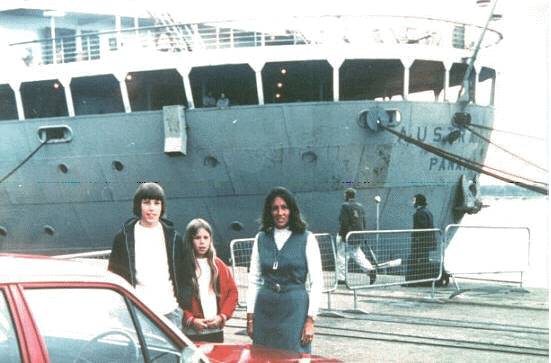 Before
learning more about the ship and her rich history, we had to locate
our assigned stateroom. It was a four-berth cabin, number 1240, on C
Deck, port side, located as far aft as it was possible to venture on
that deck. In addition to being somewhat remote from the rest of the
ship, it was near the ship’s propellers.
Before
learning more about the ship and her rich history, we had to locate
our assigned stateroom. It was a four-berth cabin, number 1240, on C
Deck, port side, located as far aft as it was possible to venture on
that deck. In addition to being somewhat remote from the rest of the
ship, it was near the ship’s propellers.
In the photograph on the left, it was behind us, but a deck lower than can be seen! Originally, part of the crew’s quarters, our cramped cabin had been created during a major conversion that had taken place in 1964, when the AUSTRALIS’ passenger capacity had been doubled.
Settling into our cabin, we listened to the hum of the ship’s engines and sensed a gentle motion as we headed down the English Channel. At 10 AM the next day, we participated in the regulation lifeboat drill, being instructed as to the routine required in the event of an emergency. The following day, after everyone had had a little more time to get their bearings, we attended the Captain’s Welcome-Aboard cocktail party. That traditional event was held in the main lounge on Promenade Deck; a beautiful and stunningly spacious room that rivaled the lobby of any grand hotel.
A few days later, AUSTRALIS made a port call in the Canary Islands. Little did I know, that I would be reunited, years later, in those same islands with MY ship under much different circumstances.
As time went on, the ship’s layout became more familiar and we discovered the numerous facilities available, including a cinema, hospital, indoor and outdoor swimming pools and a wide range of sports facilities. We also learned more about the history of the ship and marveled that the grandeur of her pre-World War Two décor had survived years of wartime and a change in ownership; virtually intact.
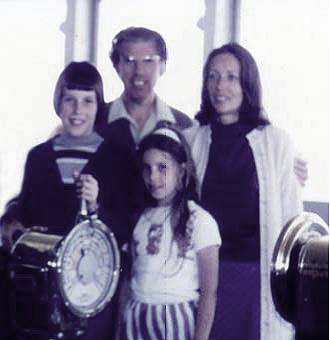 However,
for a lad of twelve, such niceties were not nearly as exciting as the
opportunity to visit the ship’s bridge, and pose with family members
there.
However,
for a lad of twelve, such niceties were not nearly as exciting as the
opportunity to visit the ship’s bridge, and pose with family members
there.
We left England on 16 September 1974 on Voyage 46 Southbound, and arrived in Auckland, New Zealand, on 18 October 1974. For most people traveling to New Zealand, that would have been the end of a lengthy, enjoyable and memorable ocean voyage on the ship taking them to their brave new world.
But as it turned out, life in New Zealand did not live up to my Mother and Father’s expectations. Simply put, perhaps, my parents’ hearts and minds remained in England, therefore they decided to cut short their working holiday and preparations were made to return to England. We arranged to leave Auckland in January of 1976, happily finding passage once again onboard AUSTRALIS. The prospect of returning to England on the same ship filled me with joy.
Returning Home ...
This time we were on Voyage 52 Northbound, departing Auckland 27 January 1976 and arriving in Southampton on 24 February 1976. Our four berth cabin was number 1007 on B Deck; an inboard space a little larger, further forward and one deck higher than we had previously had been assigned.
The date of our departure coincided with my sister’s 10th birthday. A cake and birthday card awaited her at the evening meal, making for a convivial start to the trip. Unlike our first voyage in AUSTRALIS, this time we transited the Panama Canal. A buffet had been arranged on the Promenade Deck for our passing through the Canal. It was certainly a fascinating and memorable experience.
We then made a brief call at San Juan, Puerto Rico, where - as I was to learn years later - the AUSTRALIS (originally named the AMERICA) had made her very first Caribbean port call in August of 1940. Days later, we docked at the Ocean Terminal from which we had sailed about 18 months before. A cold but sunny winter’s day greeted us as we stepped ashore onto English soil, and we were almost overwhelmed by familiar sights and sounds which we had missed so much.
We were truly home.
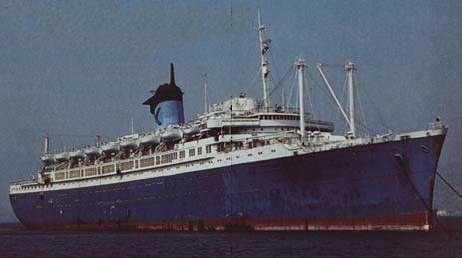 Soon,
our times onboard AUSTRALIS became just pleasant memories; largely reinforced
by fading photographs and a few bits of memorabilia. Less than two years
after we disembarked in Southampton, she made her last trip from there
to Sydney, and then was laid up at Timaru in New Zealand in November
of 1977.
Soon,
our times onboard AUSTRALIS became just pleasant memories; largely reinforced
by fading photographs and a few bits of memorabilia. Less than two years
after we disembarked in Southampton, she made her last trip from there
to Sydney, and then was laid up at Timaru in New Zealand in November
of 1977.
Under two different names, she had returned briefly, but unsuccessfully, to service for a couple of years. Her forward, dummy stack had been crudely amputated at its base. Then, in 1978, she was laid up in a remote Greek anchorage, abandoned and largely forgotten. For well over a decade her future was in doubt.
In parallel, and in stark contrast with that sad sequence of events, my life was markedly better. Over the next two decades, I completed my education, started a career in civil service, met and married Ann and we had a daughter, Sarah. I also pursued a hobby; woodworking, which would play prominently in future reunions with the ship of my youth. During that period of development in my life and the unfortunate, parallel decline in the life of and future prospects for MY ship, I had not forgotten about her. From time to time, I read notices about her situation in British maritime periodicals ...
A Visit to Greece
But that was not enough, for me. I longed to see her again. So, in 1984 Ann and I went to Greece specifically to see her. Upon our arrival, I arranged for a Greek fisherman to take me out in his boat to see the ship. But because the ship’s anchorage was directly opposite the Salamis Naval Base, we were not permitted to get very close, much less go onboard. Greek authorities found it incredulous that a British couple would travel all that way just to see an old ship, and we were not even permitted to take any photographs, suspecting us of being spies!
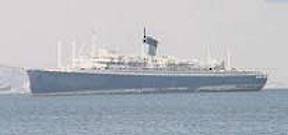 When
I asked the Naval Attaché at the British Embassy to intercede on our
behalf, he explained that the Greeks were sensitive to photography in
that area and that there had even been cases of ship enthusiasts being
locked up for spying. Discretion being the better part of valour, I
had to settle for just a distant glimpse of the idle ship.
When
I asked the Naval Attaché at the British Embassy to intercede on our
behalf, he explained that the Greeks were sensitive to photography in
that area and that there had even been cases of ship enthusiasts being
locked up for spying. Discretion being the better part of valour, I
had to settle for just a distant glimpse of the idle ship.
After that less than satisfying experience, I was overjoyed in 1992, when I saw an announcement that she was destined to come alive again, and be grandly refurbished and become a floating hotel in Thailand. Welcome news indeed, further bolstered by announcements that her art deco interiors would be largely retained.
In late 1993, I learned that the ship had been surveyed, declared sound and was being prepared for a long tow from Greece to Thailand. She also had been renamed again; this time - AMERICAN STAR - a name full of hope and promise. Or so I thought ...
The Final Resting Place ...
In early 1994, on her way to a new life in Thailand, this newly re-named vessel encountered a fierce storm. She broke free of her towline and on 18 January 1994, her life ended when she drifted aground on a remote, rocky shore in the Canary Islands and broke in two ...
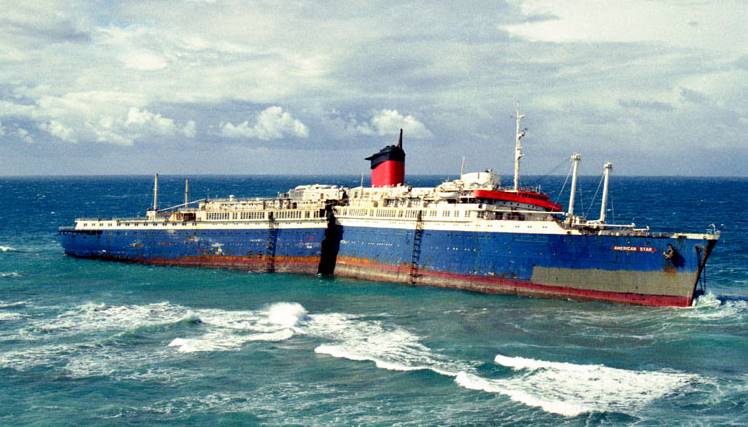
The AMERICAN STAR’s final resting place is on the west coast of Fuerteventura Island, part of the Canary group, at latitude 14 degrees 10 minutes West and longitude 28 degrees 20 minutes North, close to a headland called Punta de Playa de Garcey.
Fuerteventura is one of the lesser-known Canary Islands, but is nevertheless easily accessible. It is a popular tourist destination for those who wish to enjoy a relaxing holiday in peacefully quiet surroundings. Coupled with a mild climate, even in winter, it is a very small, relatively unspoiled island.
With this information in hand, in June of 1994, I wrote to the Direccion General de la Marine Mercante, based in Las Palmas, Lanzarote. Very kindly, he gave us the exact ship's position and confirmed that it was accessible by vehicle for photography purposes, but any attempt at boarding the wreck was forbidden. We decided to book a holiday to the island, in hopes of seeing MY ship one final time.
© 2008 Steve Tacey